Much of French media and academia, and certainly also the international plant science community now debates a hot conspiracy theory: what if Olivier Voinnet is actually innocent, a visionary genius who fell prey to a conspiracy of fraudulent colleagues and scheming bureaucrats? Indeed, French research elites and even the Government of the French Republic now raised an accusing finger at the real culprit of all French research misconduct scandals: Leonid Schneider. I tend to agree!
The Count of Monte Cristo
In 2015, Voinnet was found guilty of research misconduct, after data manipulations were reported in around 40 of his papers, virtually the entire publication record from his PhD thesis with the University of East Anglia and The Sainsbury Lab in UK, over his Strasbourg research lab with CNRS in France to his current ETH professorship in Switzerland. Voinnet even admitted to have manipulated data, for representative purposes. 8 papers were retracted with 18 corrected to date, and back in 2015 many protested that CNRS was actually too lenient. In fact, the then-CNRS president Alain Fuchs adjusted the rules on research integrity to avoid sacking Voinnet. The plant scientist was however virtually banned from returning to work in France and left stranded in his Swiss exile. His EMBO Gold Medal and his research funding was revoked (except that by ERC), and Voinnet became a persona non grata at conferences (read here and here).
This year’s second investigation by CNRS and ETH studied some (but not all) of additional evidence, but found Voinnet guilty of insufficient supervision only. This was supported by University of East Anglia, who announced that despite 2 retractions and several embarrassing corrections stemming from his PhD research, with exactly same photoshopped figures present in his PhD thesis, Voinnet is actually innocent (read here).
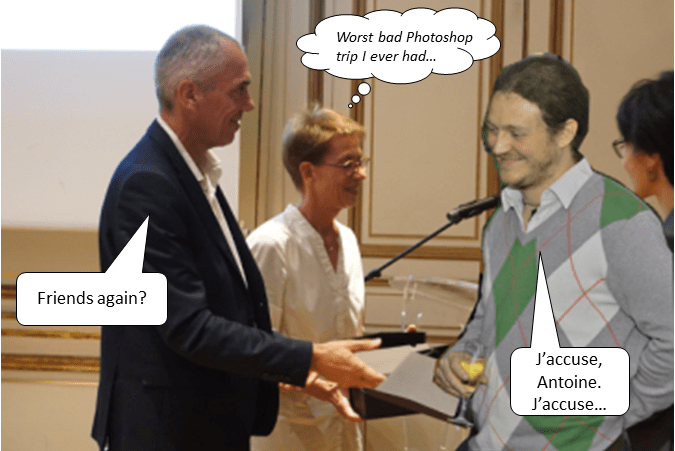
Following my prediction (or maybe rather my scheming conspiracies), Voinnet’s former right-hand man in Strasbourg, Patrice Dunoyer was found guilty of having faked data over the years and behind his master’s back. Dunoyer became the ultimate boo-man in France, Nature declared his former boss innocent and denounced the henchman’s conspiracy of forgeries. The publisher utterly forgot that they had no problem at all with accepting Dunyoer’s papers just a year ago. The traitor Dunoyer, carrier of CNRS Bronze Medal, was exiled from France to the other side of the world, to his home island of New Caledonia (as I originally reported). ETH made clear that no further misconduct evidence against Voinnet will be ever admissible, and the case is closed forever.
Voinnet himself got a lawyer to make CNRS lift the 2015 sanctions and started talking to press. He declared his newly discovered sympathy for PubPeer for its “help to clean up research literature” and modestly stated:
“I am not Dreyfus, I am not a saint, I just want the truth!”
He sure is no Dreyfus, even if some seem to think so. But Voinnet has all the potential to return to France and international plant science with a revenge spree à la Count of Monte Cristo.
Schneider, Enemy of the Republic?
France is now in a peculiar situation, research integrity-wise. And I admit it is mostly my fault, from my continuous Voinnet reporting on, which started almost 4 years ago, to the recent revelations of a manipulated figure in an old paper by French Minster for Research and Innovation, Frederique Vidal. I originally reported a duplication, which then proved a triplication.
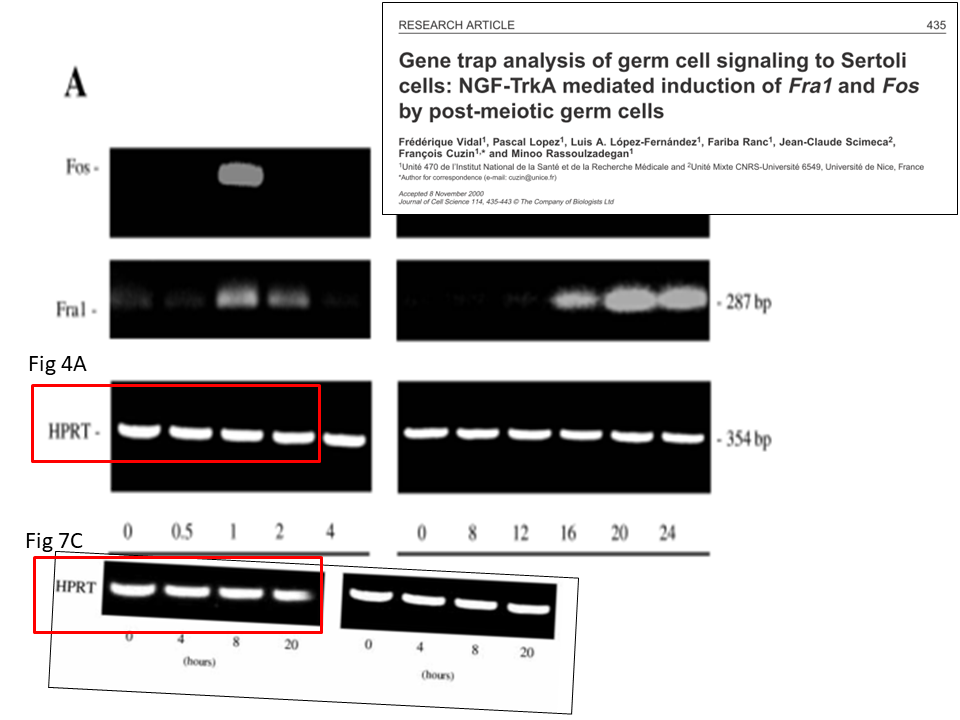
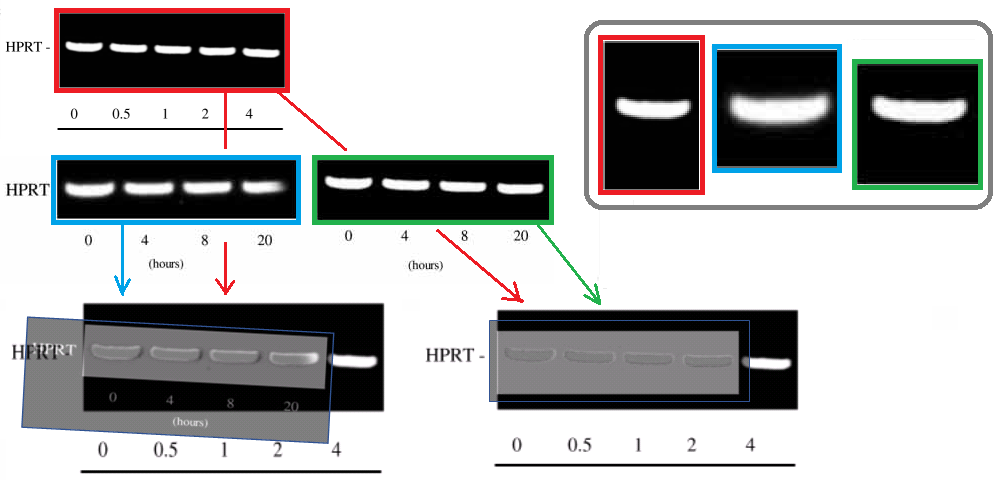
The Ministry of Research reacted swiftly and announced to be suing Leonid Schneider, on national media in NewsTank. This is how the Government of France reacts to pointing out simple facts of a duplicated gel loading control:
“Charges have been laid against a scientific publication published 17 years ago and co-authored by seven authors, including the current Minister of Higher Education,
research and innovation. These unacceptable accusations are totally unfounded. The goal sought by their author is clear: to destabilize the minister. Faced with these accusations, the Minister is studying the possibility to institute legal proceedings.”
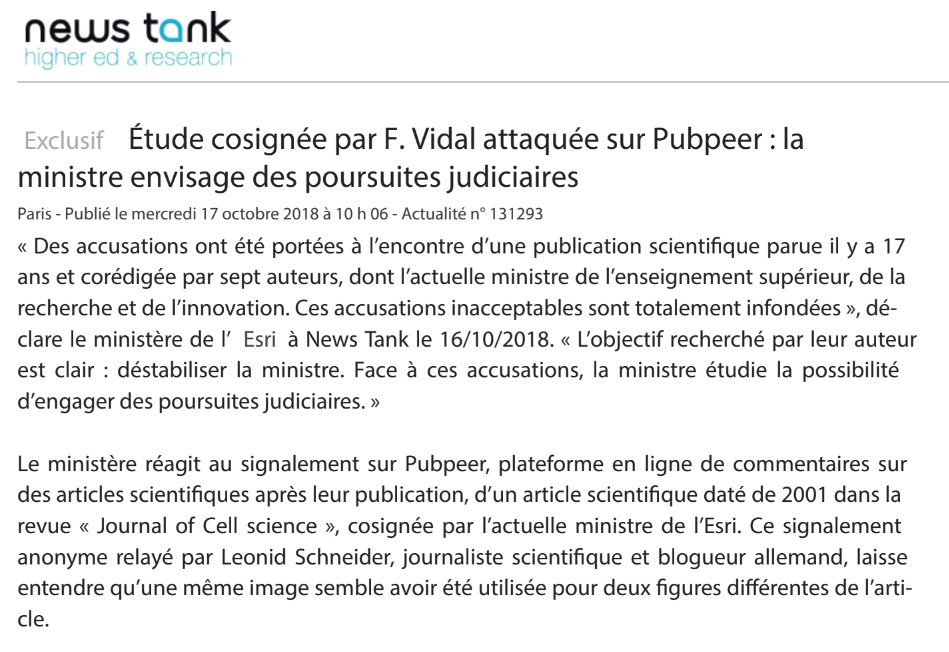
I send my two-fingered salute back.
Frederic Dardell, molecular biologist and President of ‘Université Paris Descartes where the work was done, then explained in the same NewsTank article and on Twitter, that even if Vidal’s gel image is triplicated it matters not. For one, it is a loading control, and those are anyway irrelevant. And also, the similarities are anyway accidental because using same samples on same gel apparatus produces similar-looking gel bands, if that gel apparatus is plugged in into the Infinite Improbability Drive (this outlandish theory was postulated before by the German biochemist Roland Lill).
Dardell is also quoted in NewsTank with this:
“The university chaired by Frédéric Dardel has signed an agreement with Pubpeer because it hosts one of their developers. One of the two creators of Pubpeer – Brandon Stell – is also researcher in a research unit at the University of Paris.
For Frédéric Dardel, Pubpeer is an “interesting initiative” but the system “escapes
its designers” because “some, like Leonid Schneider, turn it into a court”.
CNRS, a fraudulent swamp?
Former CNRS president Anne Peyroche is about to be crucified while we still do not know who exactly faked the figures in papers from her lab. The CNRS head biologist Catherine Jessus is holding hands with everyone in power while 500 of her colleagues signed a Stalinist letter to abolish free press and to initiate purges for dissidents (read here). Among these signatories are the former CNRS president Alain Fuchs (who now calls for “presumption of innocence” instead of evidence of data manipulation), and Guido Kroemer, cancer researcher in Paris with CNRS background and an impressive PubPeer record which I recently wrote about. The current President of CNRS, Antoine Petit, described me and other PubPeer commenters as “assholes”, compared PubPeer evidence in Jessus and Peyroche affairs to paedophilia slander, while threatening to smoke out anonymous commenters using deep net surveillance (read here).
But back to Voinnet and the affair at the Institut de Biologie Moléculaire des Plantes (IBMP) in Strasbourg, where Dunoyer was allegedly busy faking Voinnet’s research data in total secrecy.
At the end of this post is a list of Voinnet corrections and retractions. But there are actually many more papers which were never corrected, despite serious PubPeer evidence. Like this beauty, Lecellier et al Science 2005. Dunoyer is last author, but let’s not hurry pointing fingers. Charles-Henri Lecellier was actually kicked out of IBMP by Voinnet himself for manipulating data in his lab. I am not sure what this proves these days, but anyway. Lecellier was sent to Montpellier, where he set up his own data manipulation laboratory in cancer research. When he was caught out by his collaborators in Luxembourg, he received highest protection from none other but Catherine Jessus (read the introduction part here). Lecellier never had to correct a single one of his papers, though he did feature as co-author on Voinnet’s first ever retraction, plus on another retraction (Vetter et al Oncogene 2010) which Jessus initially prevented, but which eventually happened due to my reporting.
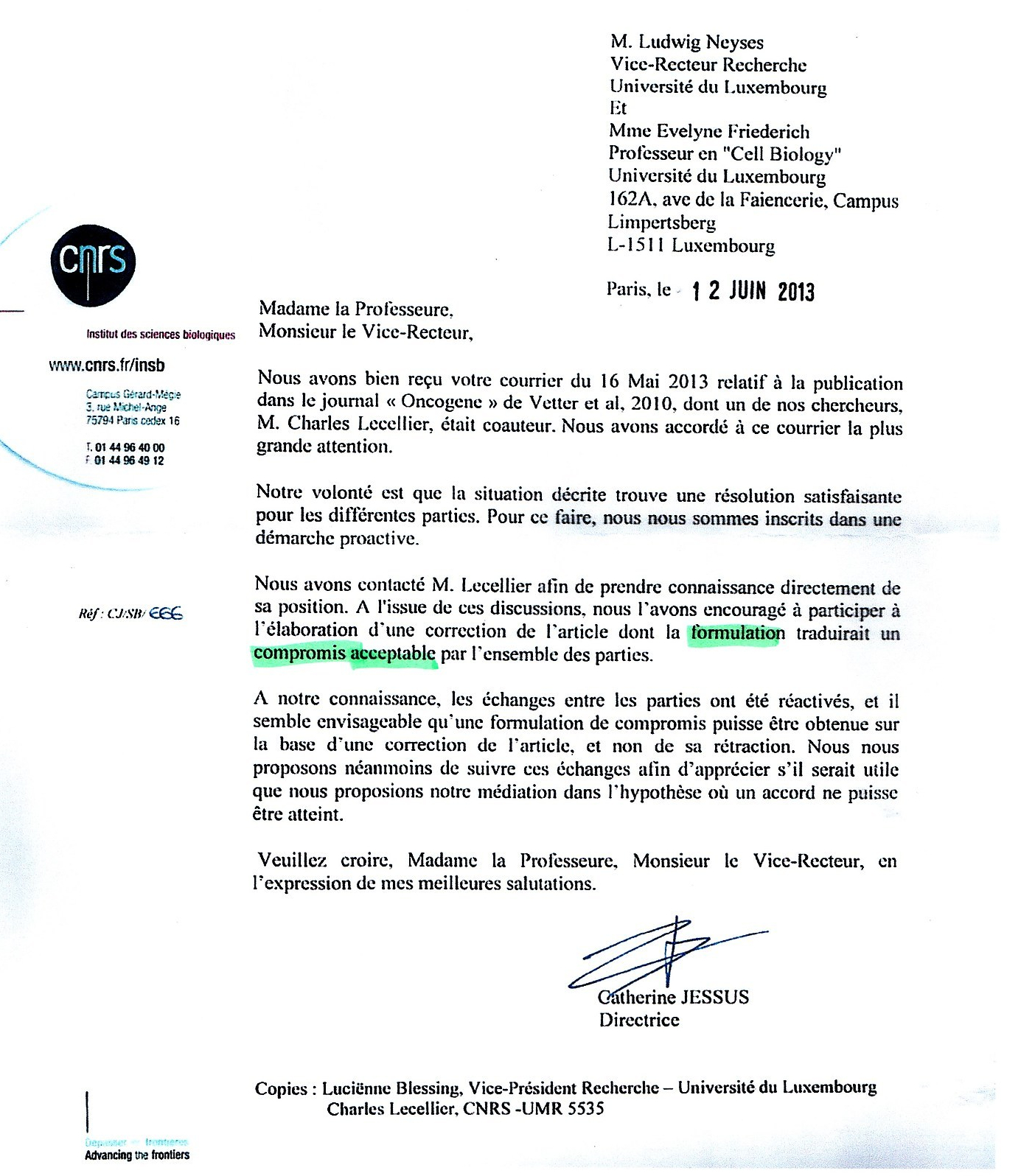
If anyone should ever bother to investigate that Science 2005 paper (hint: not likely), rest assured that Lecellier will never be implicated in anything. He is well protected in French academia, while his less lucky data manipulating colleague Dunoyer had to resort to his impressive family connections to get a governmental job in New Caledonia.
There are more suspicious names. A Voinnet co-authored paper from IBMP, Dunoyer et al Plant Journal 2002 was corrected in 2015. The correction contains a fake figure, this what apparently also what the CNRS and ETH investigation from this year found out. It takes some guts and some very special sense of humour to fake a correction, and it is also impressive that the journal didn’t bother to check. Here it is, a section of background was mirrored and duplicated.
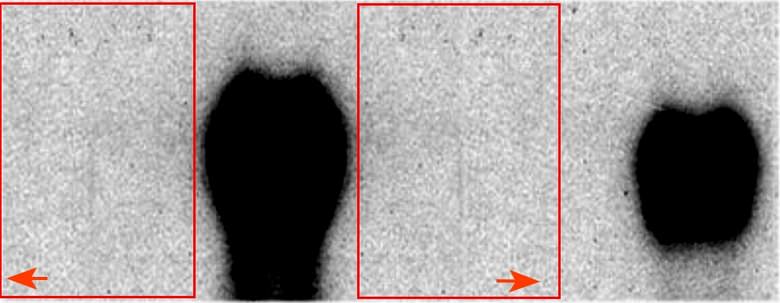
As the editor of the journal Lee Sweetlove explained, the correction was submitted by Dunoyer and the other co-first author, Sebastien Pfeffer, now group leader in Strasbourg, back then a PhD graduate at IBMP.
This Dunoyer et al 2002 paper contains quite some data from Pfeffer’s PhD thesis from 2002. Including this figure, which somehow was reused in a different context in the paper.
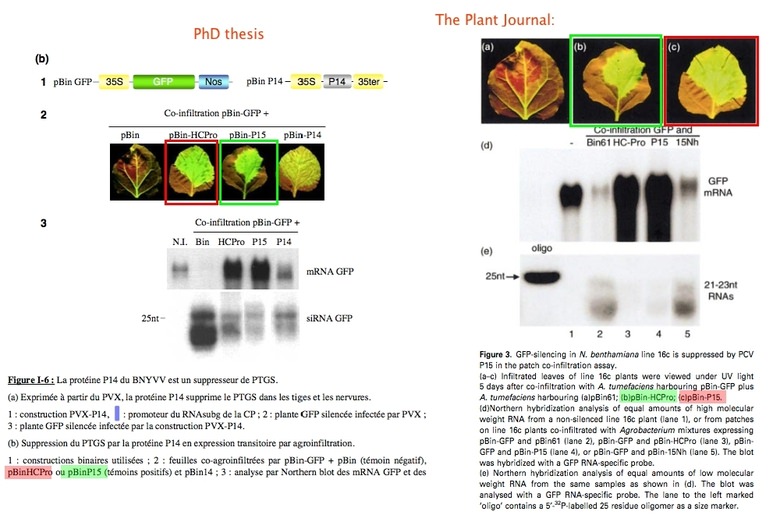
As the highlighting shows, the photograph of the plant leaf is labelled differently in Pfeffer’s PhD thesis, it shows a plant treated with a different genetic vector from what the same leaf in the Dunoyer et al 2002 paper stands for. Maybe an innocent mistake? But why was this other image from that thesis reused and not just relabelled, but also rotated 180°? Can this be an oversight also?
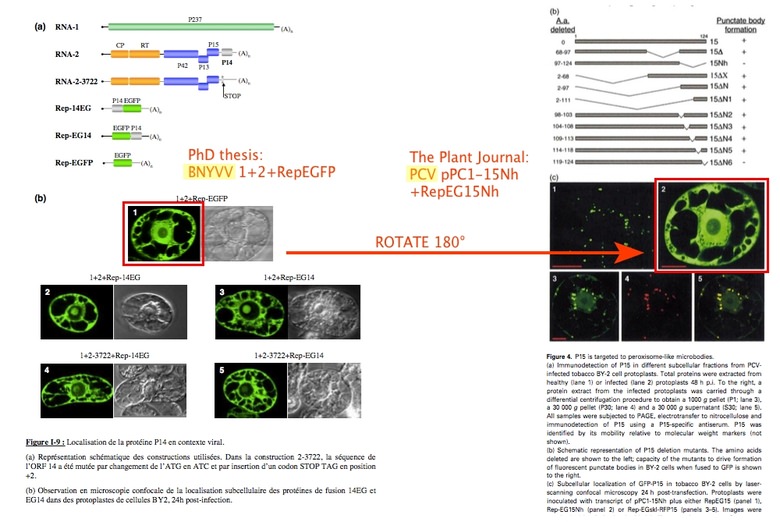
Maybe the journal will have to issue a correction to a correction now, and include this new material which one can hardly blame on Dunoyer.
Actually, Pfeffer had last year a retraction of his own, Pfeffer et al J Virology 2002, (see here for PubPeer evidence). But back when the retraction was steaming fresh and an evaluation travelling circus of Photoshop experts arrived to IBMP in March 2017, everyone apparently preferred to blame Pfeffer’s co-author on that retraction, the unlucky Dunoyer, and to keep the carrier of a running ERC Consolidator Grant out of the trouble. It might have counted that Sebastien’s dad Michel Pfeffer is an emeritus bigwig in Strasbourg and French academia, the senior even signed the Stalinist letter in support of research fraud.
Sans Dunoyer
Moving on with other examples of questionable co-authors on Voinnet’s papers. A retracted and very highly cited publication from his English PhD period, Voinnet et al Plant Journal 2003, has Susana Rivas as coauthor. That colleague from Spain, who used till recently to be CNRS group leader in Toulouse, France, was caught with much of fake data of her own, four more of her papers were retracted for data manipulation (see my reporting here). Her institutional website has been deleted now.
What about other retracted and corrected papers by Voinnet from his PhD period? There are no other suspicious names on it. Guess the conspiracy theorist will have to accept the responsibility of Voinnet here after all, because the only other common name is that of his PhD mentor David Baulcombe, who is now in Cambridge. Baulcombe allegedly used to joke that he “had to keep a close eye on Olivier from the beginning”, apparently not close enough.
Fun fact 1: the Voinnet affair initially started in late 2014 when some anonymous PubPeer sleuths started to screen Baulcombe’s papers.
Fun fact 2: Baulcombe was hosting Voinnet’s external investigator Witold Filipowicz right after he was done investigating at ETH(read here).
Fun fact 3: Baulcombe was acting as editor against PNAS guidelines on conflict of interest for the now retracted Voinnet paper Moissiard and Voinnet, PNAS 2006 (more here).
If we follow the conspiracy logic, whom to blame here? Dunoyer is not co-author, just like on several other retracted and corrected papers from Voinnet’s lab at IBMP and ETH.
Like this Ciaudo et al PLOS Genetics 2013, retracted for data manipulation after a failed correction: Dunoyer was not part of that either. Actually, why did ETH never even interview the first author Constance Ciaudo, whom they appointed as professor soon after she arrived to Zürich as Voinnet’s postdoc? Or another Dunoyer-free example, the horribly fake Deleris et al Science 2006, which even the benevolent ETH investigators set for retraction. Science‘s then-Editor Marcia McNutt explained she chose a correction as not to damage the careers of young scientists among the authors. Thanks to that, Angelique Deleris did rather well, she is tenured CNRS researcher and works under another Voinnet co-author who had to correct his paper in Science, Lionel Navarro.
If ETH would not have permanently closed the Voinnet case now, we would also be expecting to see another paper corrected, or maybe worse: Mari-Ordonez et al Nature Genetics 2013., done in Voinnet’s ETH lab, also here sans Dunoyer. The first author Arturo Mari-Ordonez was just made group leader at Gregor-Mendel-Institut in Vienna, Austria, and also that institution said they will not investigate anything here. Maybe they would if one could somehow blame Dunoyer? Another problem is: Nature Genetics is a bit confused a journal, whose own editor seems to struggle with research integrity in his own papers (read here).

Then again, the paper Sansregret et al PLOS Pathogens 2013 was retracted after the Canadian first author Raphael Sansregret admitted to me in an email from September 2015 to have manipulated the Figure 1B when he couldn’t recover the original loading control. He also declared to me that that paper’s other problematic Figure 6 was manipulated by Voinnet and Dunoyer.
Shall we assume a mass conspiracy against Voinnet then? All his colleagues, lab members and collaborators unable to stomach his genius and his success, putting fake data in to sabotage his otherwise scientifically perfectly sound visionary ideas? If we go down that route, we must include the US plant scientist and whistleblower Vicki Vance into the circle of anti-Voinnet conspirators. Though it was a Dunoyer et al paper she kept rejecting as peer reviewer in 2004, it was Voinnet himself who kept resubmitting it while manipulating its data to adjust to reviewer criticisms. If we choose to believe that Voinnet is innocent, it must be obviously Vance who tried to sabotage his research here, no? That paper is now also retracted, it was in fact Voinnet’s first ever retraction.
Not a conspiracy, just massive corruption
Very likely not just Dunoyer but some others among Voinnet’s co-authors and colleagues engaged in data manipulations also. At IBMP, photoshopping seems to be a kind of strange culture, even the director Laurence Drouard is part of the problem here, if one studies the papers she published and theses she supervised. With such a stellar example as Voinnet to show the way to success, who can blame these academic members of French science elite? Well, we can, but very, very cautiously. They are powerful people.
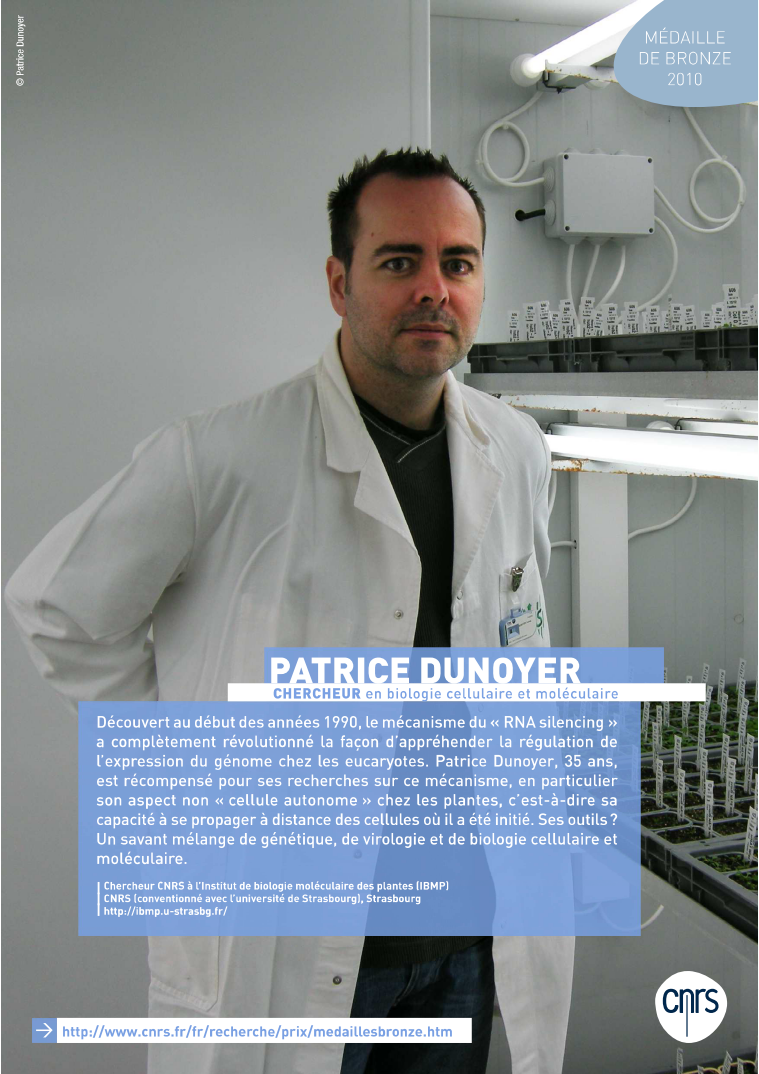
Some others of Voinnet’s co-authors maybe just knew, and were happy to play along with his and Dunoyer’s creative figure preparation if it meant big papers in big journals and big academic careers for themselves. They are still guilty, even if they never faked a gel figure in Photoshop themselves. Knowingly submitting manipulated data for publication is still research misconduct, regardless of who actually did the faking. But the research community decided these academic careers are too important to dig all that up or to ask any questions. We saw the mind-bogglingly wrong reaction of French elites to the Jessus affair, where even a critic of Stalinists, Patrick Lemaire, spoke of “questionable methods that we all applied at this time“. Are French science elites unable to understand the concept of research fraud? Is Voinnet to be absolved of responsibility because everyone does it in France, and therefore he could never have learned the basics of research integrity?
This is of course nonsense, most French researchers sure know right from wrong, yet it is another question altogether which scientific method the French academic system rather rewards. The sad state of research integrity in Strasbourg, the Jessus data manipulation affair, and her own handling of Lecellier’s activities, offer some clues.
So now we are to scapegoat everything on Dunoyer alone, and get ready to celebrate the next Voinnet paper in a big journal.
I for one would rather hear out those who did not agree to Voinnet’s way of doing science. Where are those failed lab members of his? Probably not even in academia anymore.
Voinnet RETRACTIONS:
- Brigneti G.et al.,EMBO J (1998)
- Voinnet, O.et al., Plant J. 33: 949-56 (2003)
- Dunoyer P.et al., Plant Cell 16: 1235-50 (2004)
- Moissiard G. and Voinnet O., Nat.l Acad. Sci.USA 103 (51): 19593 (2006)
- Dunoyer P.et al., EMBO J (2010)
- Dunoyer P. et al., Science 328 (5980), 912 (2010)
- Ciaudo C.et al., PLoS Genetics 9(11): e1003791 (2013)
- Sansregret R.et al., PLoS Pathogens 1(9): e1005207 (2013)
Voinnet CORRECTIONS:
- Ruiz MT et al, Plant Cell10: 937–946 (1998)
- Voinnet O, et al., Nat.l Acad. Sci.USA 96:14147–14152; (1999)
- Hamilton A.et al., EMBO J (2002)
- Dunoyer P.et al., Plant J. 29: 555-67 (2002)
- Parizotto E.A.et al., Genes & Development 18: 2237-42 (2004) 2nd Correction
- Dunoyer P.et al., Nature Genetics 38: 258-63 (2006)
- Navarro L. et al., Science 312(5772): 436-439 (2006)
- Deleris A. et al, Science 313(5783): 68-71 (2006)
- Moissiard et al, RNA 13: 1268–1278 (2007)
- Haas G. et al, EMBO J 27, 2102-2112 (2008)
- Ciaudo C.et al., PLoS Genetics 5(8): e1000620 (2009)
- Azevedo et al., Genes & Development: 24 (9): 904 (2010)
- Bennasser Y et al., Nat. Struct. Mol. Biol. 18, 323–327 (2011)
- Jay F, et al. (2011) PLoS Pathog 7(5): e1002035
- Brodersen P.et al., Proc. Nat.l Acad. Sci. USA 109: 1778-83 (2012)
- Gibbings D. et al, Nature Cell Biology 14, 1314–1321 (2012)
- Schott G. et al, EMBO J 31, 2553-2565 (2012)
- Boccara M.,et al., PLoS Pathogens 10(1): e1003883 (2014)
Update 9.01.2018. News Tank published an interview with Olivier Voinnet, who is portrayed as the most honest researcher ever, a victim of Dunoyer’s fraud and Jessus’s scheming, and an expert in research integrity. The interview is heavily paywalled, not even searchable on Google, but some kind person uploaded a copy here. Please do not download it it will make News Tank sad, they value their copyright.
Update 18.01.2019. Surprise! Well, not really. Turned out same Chicken of Dishonour Legion, Francis-Andre Wollman, also acted as original Voinnet investigator in 2015. This was revealed by Le Monde,
Basically, Wollman found Voinnet guilty of fraud for very similar data manipulations found later in Jessus’ papers. Yet there, Wollman saw nothing untoward whatsoever. Same kind of gel band copy-pasting can be either fraudulent or perfectly scientific, depending on who did that.
I think the best way to celebrate this, is to flag a gel duplication in a paper Wollman co-authored last year, Wittkopp et al Plant J 2018
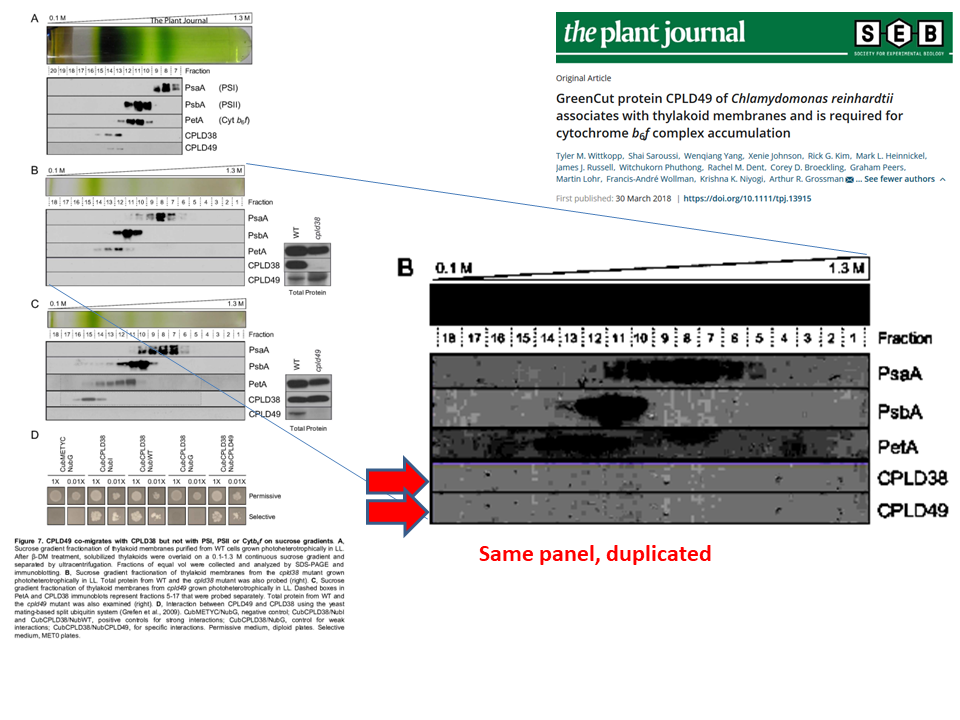
Update 23.01.2019. Another Wollman co-production, Cardol et al PNAS 2009.


Donate!
If you are interested to support my work, you can leave here a small tip of $5. Or several of small tips, just increase the amount as you like (2x=€10; 5x=€25). Your generous patronage of my journalism will be most appreciated!
€5.00


This story reminds me to remarks in ‘Stop ignoring misconduct’ by Donald Kornfeld and Sandra Titus at
https://www.nature.com/news/stop-ignoring-misconduct-1.20498 (open access). This story also reminds me to a viewpoint by Robert Hauptman in https://www.emeraldinsight.com/doi/abs/10.1108/JICES-09-2015-0030
This viewpoint by Robert Hauptman starts with: “Ethical considerations in publishing span a broad and expansive territory and include both scholarly and popular material. Concerns in the former realm are very different from those that rear their ugly heads in the latter, where, for example, Clifford Irving managed to convince McGraw-Hill that he had an exclusive agreement with reclusive Howard Hughes to write his biography; he did not. He received an astonishing three-quarters of a million dollar advance; he also went to prison!”
Robert Hauptman also states in his viewpoint: “One of the reasons why scholars falsify, fabricate and plagiarize (among other misdeeds) is that they often are not punished at all, or if they are, the punishment is ludicrously ineffective. Instead of losing positions, paying hefty fines, being precluded from publishing anywhere (through editorial collusion, so to speak), or spending some time in prison, they are barred from the USA federal grants for three years or (horror of horrors) they are not allowed to act as peer reviewers.”
LikeLiked by 1 person
FWIW, when submitting a proposal to the French National Research Agency ANR, one now has to declare that all project participants will adhere to a charter of ethics (“Charte de déontologie et d’intégrité
scientifique”), containing in particular an item on protecting whistleblowers (“Protéger les lanceurs d’alerte”):
Click to access ANR-Charte-deontologie-et-integrite-scientifique-2018.pdf
LikeLiked by 1 person
I invite my readers to visit this bizarre Twitter thread here:
Personally, i think this obsessionof French academia and public officials with my person is unhealthy and lost all proportion.
Otherwise I wager a prediction here: very soon Voinnet’s lawyers will get all CNRS sanctions from 2015 against him lifted, with an apology. The silent agreement will be though that he stays in Switzerland until his retirement (Voinnet is 46 and has at least 20 years to go) and does not try to return to Strasbourg. Voinnet might even write a book.
He won’t be able to de-retract his papers, but will compensate by publishing new ones, in elite journals.
Catherine Jessus will not put forward her candidacy when the position of Chief Biologist at CNRS is to be renewed.
LikeLike
This thread is from a group of academics (behind the pseudonym JPVernant) who seems to defend the idea that Voinnet is a victim of the current and former directions of CNRS. Their tweets (clearly in favour of Voinnet) are interesting to read because they link to newspapers articles (in French) which discuss what might be going on behind the scenes and why it seems to be so important for CNRS to protect Peyroche and Jessus, but keep blaming Voinnet.
Perhaps there is a bit of political intrigue in the treatment of Voinnet’s case in France. But one cannot deny the number of retractions and corrections as well as the report of Vicki Vance back in 2003 concerning one of Voinnet’s work. I guess that for scientists who do not take ethics and good practice as adjustable variables these things have a meaning.
LikeLike
Today, 30.10.2018, Catherine Jessus announced to her CNRS colleagues that she will resign as Head of Biology Unit at CNRS by the end of this year.
LikeLike
The Dunoyer et al Plant J 2002 paper has been retracted. I apologise if this was my fault.
https://onlinelibrary.wiley.com/doi/abs/10.1111/tpj.14702
Predictably, Voinnet is protected and shares no responsibility. But Pfeffer might be in a bit of a pickle.
LikeLike
Anecdote time! Two CNRS researchers, both on detachment to California, met the Watchdogs Ivan Oransky (Retraction Watch) and Brendon Stell (PubPeer) for a roundtable, in March 2016.
http://journals.sagepub.com/doi/abs/10.1177/0306312718756202
Thus impressed, Emmanuel Didier and Catherine Guaspare wrote another piece, an essay on “the Voinnet Affair”, it is linked in the references to the Watchdogs roundtable article as:
Guaspare C and Didier E (in press) The treachery of images: The Voinnet affair. In: Biagioli
M and Lippman A (eds) Metrics and Misconduct: New Ecologies of Academic Research.
Cambridge, MA: MIT Press.
The book cannot be found as of today. But this was what I found on Didier’s institutional website: https://www.cmh.ens.fr/Didier-Emmanuel-598
PEER REVIEWED BOOK SECTIONS
• 2017, with Guaspare, C., “The Voinnet Affair, Testing the Norms of Scientific Image Management”, in Biagioli M. and Lippmann A. (Eds.), Beyond Publish or Perish : Metrics and the New Ecologies of Academic Misconduct, Cambridge, MIT Press, in press.
But also:
PEER REVIEWED JOURNAL ARTICLES
• 2017, with Guapsare C. “The Treachery of Images : the Voinnet Affair”. Hau, Journal of Ethnographic Theory, Accepted with modifications.
None of these works can be found online or on publisher’s website, when searching by authors’ names only. What happened? Did CNRS pull the plug on that assay? Did some watchdog eat the paper? I wrote to authors and will update if I receive a reply.
LikeLike
Priority!

LikeLike
It is funny that the French Republic is trying to protect such an aristocracy from the public gaze.
I imagined that some would stick to some of its guiding principles.
LikeLike
All reports on this case, For Better Science/Nature/LeMonde, fail to capture the difference between the misleading ETH press release and the correct CNRS press release.
The recent investigations by ETH and CNRS only involved four Voinnet articles that had already been corrected.
Corrections were found incomplete because additional misconduct was discovered in those four articles, and even some corrections themselves involved new misconduct. Voinnet did not make and was not aware of those additional misconducts, and did not falsify figures for the corrections. He and some of the other co-authors wanted that rectified. THAT’S ALL!
The ETH press release intentionally tries to make Voinnet look innocent of all misconduct in his papers ever. I can’t believe that even Nature copies their suggestive language without asking details (Voinnet innocent? Innocent of WHAT exactly?).
The CNRS press release is correct and not misleading, but nobody bothers to read that with fresh eyes.
What is wrong with scientists?
LikeLike
“Following an in-depth examination of the scientific practices and approaches of the two researchers, the disciplinary hearing judged that Patrice Dunoyer’s responsibility in this new scientific misconduct had been proven. With regard to Olivier Voinnet, his active participation in fabricating the corrections that were called into question was not established; nevertheless, CNRS management deemed that he could not be cut off from his responsibility as group leader.”
LikeLike
This posting also reminded to an editorial in 2012 in the ornithological journal Ardea about cases of fraud in the field of ornithology Editor-in-Chief Rob Bijlsma wrote in this editorial:
” (……) Closer to home, in Dutch ornithology, it also took many decades before the truth surfaced in a case of fraud which is not fully exposed yet, and which may have still wider ramifications. The scene is Indonesia, the time pre-war. Jan-Hendrik Becking had been in and out of the Bogor Zoological Museum on West Java since primary school. He learned to prepare bird skins, and started collecting birds and eggs. At the same time he became acquainted with Max Bartels Jr., the oldest of the three sons of Max Bartels Sr., known for their large collection of Indonesian birds, eggs and nests (presently in Naturalis Biodiversity Center, Leiden). Becking had free access to these collections and took extensive notes of skins and egg measurements. His intimate knowledge came to stead when – after the Second World War had come to an end – the collections of Bartels, Bouma and Becking were found to have been raided for clutches of the rarer and difficult-to-obtain clutches. These disappearances coincided with the presence of Andries Hoogerwerf in the Bird Division of the Bogor Museum during the war. Hoogerwerf wrote extensively about the breeding biology of Javan birds, mostly in Limosa (especially Vol. 22: 1–277, 1949), but also in Zoologische Verhandelingen (88: 1–164, 1967). Becking’s detailed research unequivocally proves that Hoogerwerf selectively stole clutches and skins from the above-mentioned collections to enrich his own. To make matters worse, he falsified information on dates and – sometimes – localities to cover up for this theft. Becking unsuccessfully tried to publish this fraud in Ardea in the late 1960s, but as the subject was considered too sensitive (Hoogerwerf died in 1977, and during his lifetime and long after was considered a brilliant observer and photographer; Voous 1995: 278–280), publication was refused. Becking’s paper with allegations had been shown to Hoogerwerf, which may have led to the destruction of eggs from the Bouma collection by Hoogerwerf to eliminate incriminating evidence (these eggs were described in his 1967-publication, but were found missing from his collection after his death). Egg theft was just part of Hoogerwerf’s malpractice. Eight bird species reported by him from the western islands of Flores are unknown for these islands, and these records are questionable. He is also known to have ‘photo-shopped’ pictures of birds and –possibly – Javan Tiger Panthera tigris (the ‘famous’ photograph from the Ujung Kulon Nature Reserve). The resemblance with the Meinertzhagen case is uncanny: known to be unreliable during their lifetimes, but only exposed much later. Thanks to Becking, we now know that information published by Hoogerwerf is untrustworthy, and that his collection should be used with great care. Jan-Hendrik Becking died on 16 January 2009.”
The paper by J.-H. Becking (“The Bartels and other egg collections from the island of Java, Indonesia, with corrections to earlier publications of A. Hoogerwerf by Jan-Hendrik Becking”) was published in 2009 in the peer-reviewed journal ‘The Bulletin of the British Ornithologists’ Club’, see http://boc-online.org/bulletin for some backgrounds about this journal.
The paper can be read for free at https://www.biodiversitylibrary.org/item/182875#page/26/mode/1up
It should be noted that Andries Hoogerwerf had successfully sued J.-H. Becking for defamation in the late 1960s.
See also https://en.wikipedia.org/wiki/Andries_Hoogerwerf
Backgrounds about Ardea at http://www.bioone.org/toc/arde/100/2 (the editorial can be downloaded for free from http://www.nou.nu/ardea/contents.php?key=choice (Bijlsma R.G., 2012, Editorial: Ornithology from the tree tops. ARDEA 100 (2), 111-112)).
LikeLike
https://www.sciencesetavenir.fr/fondamental/fraudes-scientifiques-le-cnrs-sera-impitoyable_129407
CNRS will be pitiless (for whistleblowers?).
LikeLike
Petit starts to understand how (disastrous) the biomedical research enterprise works. He needed some time for that. Now we have to wait and see if he has what it takes to change things. The CNRS descriptions about Voinnet are simple and correct: Guilty > 2 years suspension; Additional new but lesser guilt as failing supervisor discovered > Warning.
The narrative “Not guilty, others did it” only comes from the ETH.
LikeLike
ETH has lost a major amount of credibility. Its a shame on its entire faculty who the organisation is acting in this matter.
LikeLike
It’s a nice example of how messages are tailored/framed/twisted, just like scientific articles, to get the desired results. These people are used to that, and nobody ever stops them.
It’s about who wants what. The CNRS does not care much about Voinnet anymore, so can choose to be more honest.
However, I also give Petit the benefit of the doubt. He can’t have gotten really far in his field without true talent and work ethics, so he probably is genuinely disgusted by what is going on in biomedical research. It was not so strange that as an outsider he thought that his CNRS team of “top people” should have written a first class report on the Jessus case, so he ordered to have that published. That was quite funny.
LikeLike
Pingback: Homeopathy business at CNRS in Strasbourg – For Better Science
Sorry, in the Cardol et al PNAS 2009, I skipped yet another strange duplication in Figure1. So the very first data item shown in this paper is there twice. WT/Min and WT/Min+M are the same after PI/2 right rotation and a vertical flip, a very unlikely unintentional error !
LikeLike
Like this? Let’s see what PubPeer moderators say.

LikeLike
Pingback: Spanish elites rally in support of data manipulation – For Better Science
Pingback: Inspector Voinnet, Wollman in fraud-overdrive, and Farewell to Jessus – For Better Science
I sent Leonid evidence of another manipulated blot in highly cited Pfeffer et al. Nature Methods volume 2, pages 269–276 (2005) from the T. Tuschl lab.
LikeLike
And here it is:

LikeLike
Pingback: Frederique Vidal, Minister for Research and gel band duplication – For Better Science
Pingback: Rick Vierstra probably meant well – For Better Science